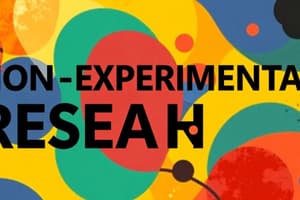Podcast
Questions and Answers
Which research method involves observing behavior in a controlled environment set up by the researcher?
Which research method involves observing behavior in a controlled environment set up by the researcher?
- Naturalistic observation
- Systematic observation
- Archival research
- Contrived observation (correct)
A researcher analyzes crime statistics from police records to study trends in criminal behavior. Which type of research approach is being used?
A researcher analyzes crime statistics from police records to study trends in criminal behavior. Which type of research approach is being used?
- Systematic observation
- Archival research (correct)
- Case study
- Survey research
What is a primary goal of naturalistic observation?
What is a primary goal of naturalistic observation?
- To administer psychological tests to a large sample
- To describe and understand behavior in a natural setting without intervention (correct)
- To establish cause-and-effect relationships
- To control all variables in the environment
Which of the following is a disadvantage of participant observation?
Which of the following is a disadvantage of participant observation?
What is the main purpose of using a coding system in systematic observation?
What is the main purpose of using a coding system in systematic observation?
What concern is addressed by researchers using ‘blind’ raters in observational studies?
What concern is addressed by researchers using ‘blind’ raters in observational studies?
Which type of rating scale would be most appropriate if you want to get a visual representation?
Which type of rating scale would be most appropriate if you want to get a visual representation?
A researcher is studying the effects of a new teaching method on student performance. Students are given achievement tests before and after the new method is implemented. Which type of research is this?
A researcher is studying the effects of a new teaching method on student performance. Students are given achievement tests before and after the new method is implemented. Which type of research is this?
What is the primary disadvantage of using archival research?
What is the primary disadvantage of using archival research?
What is meant by the term 'reactivity' in observational studies?
What is meant by the term 'reactivity' in observational studies?
In survey research, what is social desirability bias?
In survey research, what is social desirability bias?
Which of the following is a potential solution to the issue of reactivity in observational studies?
Which of the following is a potential solution to the issue of reactivity in observational studies?
Which of these is an advantage of case studies?
Which of these is an advantage of case studies?
A researcher wants to study the behaviors of children interacting with a specific toy in a controlled lab setting. Which observation method is most suitable?
A researcher wants to study the behaviors of children interacting with a specific toy in a controlled lab setting. Which observation method is most suitable?
What should researchers avoid when wording questions in survey research?
What should researchers avoid when wording questions in survey research?
Flashcards
What is a case study?
What is a case study?
Observation and description of a single case, often an individual.
What is archival research?
What is archival research?
Using existing records to study behavior, like census data or written documents.
What is survey research?
What is survey research?
Administering a survey instrument to a sample of individuals from a population.
What is systematic observation?
What is systematic observation?
Signup and view all the flashcards
What is observational research?
What is observational research?
Signup and view all the flashcards
What is naturalistic observation?
What is naturalistic observation?
Signup and view all the flashcards
What is participant observation?
What is participant observation?
Signup and view all the flashcards
What are narrative records?
What are narrative records?
Signup and view all the flashcards
What is contrived observation?
What is contrived observation?
Signup and view all the flashcards
What is experimenter bias?
What is experimenter bias?
Signup and view all the flashcards
What are case studies?
What are case studies?
Signup and view all the flashcards
What is archival research?
What is archival research?
Signup and view all the flashcards
What is survey research?
What is survey research?
Signup and view all the flashcards
What are research set biases?
What are research set biases?
Signup and view all the flashcards
What to consider in question wording?
What to consider in question wording?
Signup and view all the flashcards
Study Notes
Approaches to Nonexperimental Research
- Case studies involve observation and description of a single case, often an individual
- Archival research uses existing records to study behavior, such as census data, statistical records, survey archives, and written documents
- Content analysis of written materials in archival research typically requires a coding system
- Psychological testing involves assessing psychological traits like extroversion and intelligence
- Survey research administers a survey instrument to a sample of individuals drawn from a population
- Systematic observation involves observing one or more specific behaviors in a well-defined setting
- Systematic observation is primarily quantitative and requires a coding system
Types of Observation
- Observational research encompasses studies that observe and attempt to describe the behavior of people or animals
- Types of observational research include naturalistic observation, systematic observation, contrived observation, case study, and archival research
Naturalistic Observation
- Naturalistic observation occurs when a researcher makes observations in a particular natural setting (the field)
- This method typically extends over an extended period and uses various techniques to collect information
- Naturalistic observation is often used in psychology, sociology, ethnology, and anthropology
- It identifies and measures behavior as it occurs in everyday life and can be measured at the time or recorded for later coding
- Naturalistic observation produces a rich and complex data set
- It is primarily qualitative rather than quantitative and has ecological validity, as it occurs in situations similar or identical to everyday life experiences, minimizing reactivity
- The goal is to describe and understand how people in a social or cultural setting live, work, and experience the setting without intervention
- Methods include observing, interviewing, and examining documents like newspapers or memos
- Jane Goodall's chimp studies, where she dedicated her life to studying chimps' natural behavior, is an example
- Cognition in the Wild (Hutchins, 1995) studied cultural behavior mechanics
Participant Observation
- Participant observation involves watching people or animals in their natural habitats while actively participating in their situation
- Participant observers can be disguised (not revealing their researcher status) or undisguised (being aware of the researcher)
- An example includes a researcher analyzing hate crimes entering "White racist internet chat rooms" as a newbie (Glaser, Dixit, & Green, 2002)
- Advantages include providing important insights as a member of the group
- Disadvantages include the potential to lose objectivity by identifying too much with the group
Narrative Records
- Narrative records involve full descriptions of a participant's behavior using audio and/or video recording equipment
- This method attempts to record everything, including settings, events, and behaviors
- The researcher makes interpretations and supports them with examples of observed events
- Narrative records are primarily qualitative
- Piaget's notes on everything a child did and said during a specified period exemplify this
- Advantages include providing a good start for getting new theoretical ideas about behavior
- Disadvantages include not being useful for studying specific questions because the data is not organized
Qualitative Analysis
- Naturalistic observation, along with most qualitative analyses, poses difficulties in analyzing observations
- The researcher sifts observations to develop hypotheses or accounts for the observed data
- Negative case analyses are performed to examine observations inconsistent with the working hypothesis
- Difficulties in data interpretation include experimenter bias (selective observation), subjectivity (idiosyncrasies in observations), and positive bias (failure to seek occurrences not predicted by the hypothesis)
Systematic Observation
- Systematic observation involves observing one or a few specific behaviors in a particular setting
- It relies on quantitative procedures for recording data and requires a coding system to define and measure the behaviors recorded
- Advantages include the ability to test hypotheses
- Disadvantages include potentially missing interesting behaviors not part of the checklist
- Social behavior in young children is the example of how to observe and record for each child every 15 minutes
Contrived Observation
- Contrived observation occurs in a controlled setting set up by the researcher in a lab or the field
- Advantages include allowing the researcher to control the situation and see things they might not otherwise see
- Disadvantages include the situation being less natural
- Examples include:
- Ainsworth and Bell's (1970) "strange situation" study, in which children were put into specific scenarios in a lab
- Simons and Levin's (1998) "change blindness" study with directions
- Valentino, Cicchetti, Toth, & Rogosch (2006) observing interactions in set contexts
- The Marshmallow Study where kids behaviors if they ate the marshmallow or not were observed
Observational Studies: Advantages and Disadvantages
- Primary advantage: High external validity, the data collected inherently describes real-world behavior
- A primary disadvantage is reactivity, where the presence of the investigator may change behavior
- A second major disadvantage is experimenter (observer) bias, which affects which behaviors researchers choose to observe and record
- Some things that counteract this is multiple raters and reliable scoring rubrics
Case Studies
- Case studies are in-depth descriptions of a single individual, using personal history, observation, psychological testing, and experimentation
- These are useful for studying a person with a rare condition
- Examples include "Genie" and "H.M."
Archival Research
- Archival research uses previously existing records to answer research questions
- These records include public records (census data, police records), previously existing survey data, and published records
- Statistical analyses (e.g., correlational analysis) can be performed on the data, like Gwanltney-Gibbs (1986) analysis of marriage license applications
- Advantages include answering questions that can't be answered with any other method and avoiding reactivity
- Disadvantages include being limited by the accuracy of the original data collection and not knowing if procedures for collecting data were reliable and valid
Survey Research
- Survey research takes a snapshot of a state at a particular moment in time
- Repeated measures allow the researcher to illustrate changes across time
- Potential research set biases includes responding to all questions from a particular perspective rather than responding to each question directly
- Biases include social desirability, the halo effect, yea-saying and nay-saying responses, and extreme and middling responses
Constructing Questions
- Defining the research objective is key to constraining questions to those that address the fundamental components to be addressed by the research
- Focus on attitudes and beliefs (opinions, etc.), facts and demographics (verifiable facts), and behavior (actions rather than attitudes)
- Using pre-existing questionnaires is valuable/better because of known patterns of responses and its well-normed, has higher validity and reliability
Question Wording
- When designing survey questions, use familiar terms (avoid jargon)
- Also, you want to use precise terms (avoid vague terms)
- Ensure that the questions are grammatically clean and avoid overloading working memory
- Use consistent question stems, keep the questions simple (5th-grade reading level), and avoid double-barreled and "loaded" questions
- Negative wording can be confusing and can also mess with structural validity
Types of Rating Scales
- Graphic (visual) rating scales
- Non-verbal (images, not words)
- Likert (e.g., agree-disagree)
- Semantic differential (e.g., happy-sad)
- Guttman (presuppose previous items are true)
- "High frequency" scales
Formatting, Pilot Testing, and Administration
- Examples include Formatting, professional appearance, spacing, clear instructions, logical sequence of questions, and attention checks
- Refining the questions with pilot testing and debriefing is good
- There are also "think-aloud" protocols
- Other examples include individual vs group, interview vs questionnaire, and mail vs internet vs phone/text etc
Studying That Suits You
Use AI to generate personalized quizzes and flashcards to suit your learning preferences.




